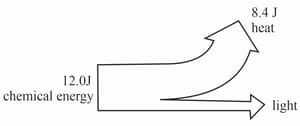David Sang and Darrell Hamilton Solutions for Chapter: Energy Stores and Transfers, Exercise 2: Exercise 6.2
David Sang Physics Solutions for Exercise - David Sang and Darrell Hamilton Solutions for Chapter: Energy Stores and Transfers, Exercise 2: Exercise 6.2
Attempt the free practice questions on Chapter 6: Energy Stores and Transfers, Exercise 2: Exercise 6.2 with hints and solutions to strengthen your understanding. Physics for Cambridge IGCSE workbook solutions are prepared by Experienced Embibe Experts.
Questions from David Sang and Darrell Hamilton Solutions for Chapter: Energy Stores and Transfers, Exercise 2: Exercise 6.2 with Hints & Solutions
A washing machine has a motor that turns the drum. In a particular washing machine, the motor is supplied with of energy each second. Of this, of energy is used to turn the drum. The rest is wasted as thermal energy. Calculate the amount of energy wasted each second.
A washing machine has a motor that turns the drum. In a particular washing machine, the motor is supplied with of energy each second. Of this, of energy is used to turn the drum. The rest is wasted as thermal energy. Calculate the efficiency of the motor in the washing machine. Give your answer as a percentage.
A washing machine has a motor that turns the drum. In a particular washing machine, the motor is supplied with of energy each second. Of this, of energy is used to turn the drum. The rest is wasted as thermal energy. Explain why we say that energy from the washing machine is 'wasted' as thermal energy.
Figure shows the energy transfers in a light bulb each second. A coal-fired power station is used to provide the electricity. Calculate the efficiency of the bulb.

Draw an energy flow diagram for the following power transmission system:
- Solar panel ( efficient)
- Solar inverter (converts DC to AC, efficient)
- Step-up transformer ( efficient)
- Overhead power transmission cable ( efficient)
- Step-down transformer efficient).
Assume that there is of solar energy arriving at the solar panel.
Draw an energy flow diagram for the following power transmission system:
- Solar panel ( efficient)
- Solar inverter (converts DC to AC, efficient)
- Step-up transformer ( efficient)
- Overhead power transmission cable ( efficient)
- Step-down transformer efficient).
Assume that there is of solar energy arriving at the solar panel.
What is the overall efficiency of the power transmission system?
